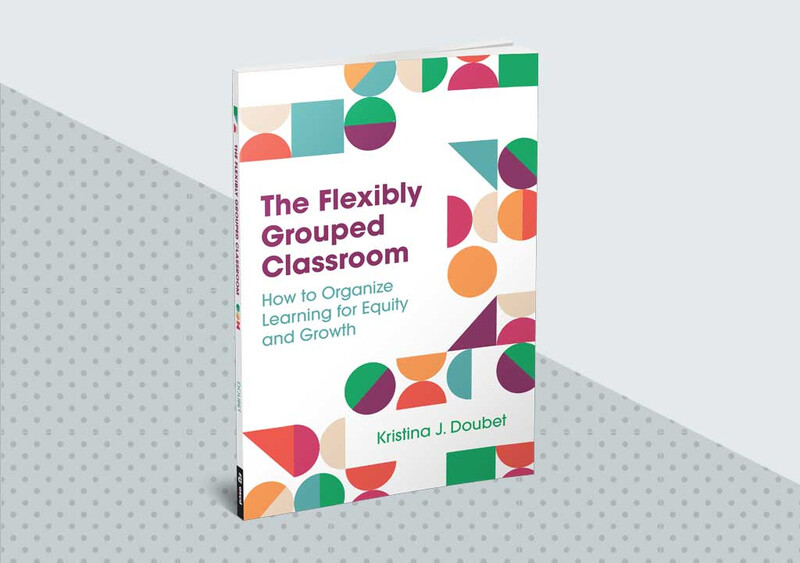Tasks at varying levels of Bloom’s Taxonomy. Extra work for early finishers. Relying on students who “get it” to help those who don’t. In my early attempts to differentiate instruction, these were among my common strategies. While they were accepted practice at the time, they never quite settled with me. Was it right to ask only some students to think critically? Why was I “punishing” those who finished early? How did I address parents’ concerns about their curious child teaching others rather than extending their own learning?
These questions, among others, propelled me to study differentiation in more depth, where I encountered Carol Ann Tomlinson’s “teaching up”—a paradigm of thinking and working that calls on educators to “plan curriculum and instruction for students with ‘high ceilings’ of learning and then provide scaffolding that enables a very wide range of learners to access and succeed with that work” (Tomlinson, 2023).
While I established challenging goals or “high ceilings” when I planned units of study, those expectations did not necessarily translate to daily instruction. If students struggled with a goal, I backpedaled rather than proceeding with a strengths-based mentality. In other words, I would examine student work, note patterns that revealed who “got it” and who didn’t, and base instructional decision-making on those who didn’t. In doing so, I watered down my expectations, robbing all students of the rich learning experiences I had originally envisioned.
Flipping the Script
Still, there were reasons to feel good about my approach; I was administering and examining formative assessment—exit slips, drafts of essays and product segments, and so on. This is a first step in teaching up (Tomlinson, 2023). I was also using those results to inform my instruction. However, since I was only adjusting my instruction to meet some of the needs revealed, it might be better said that I was misusing those formative assessment results. I needed to turn my process upside down and begin by designing the top task first, then scaffolding up to meet all students’ needs.
While this approach initially felt counterintuitive, it dramatically improved the quality of all students’ tasks. For example, when a figurative language assessment revealed some students were already comfortable using metaphors, I tasked them with describing themselves using a conceit—an extended, unusually complex comparison. Meanwhile, students who needed more support were charged with using a series of succinct comparisons to capture their personalities. Strategically, all students were describing themselves using metaphors, albeit with appropriate challenge and support; this allowed them to seamlessly share their work at class’s end. As a result, all students were more engaged than they had been by my previous approaches, which made sense, since no one was completing rote worksheets, extra rote worksheets, or helping others complete their rote worksheets (the common practices described at this article’s outset).
I needed to turn my process upside down and design the top task first, then scaffold up to meet all students’ needs.
Teaching Up in Other Classrooms
As I transitioned to work as an instructional coach, university professor, and consultant, the lessons I learned about teaching up followed me, expanding and deepening through my partnerships with teachers. To this day, our professional development sessions may simply consist of sitting with piles of student work, sorting responses into patterns, and letting those responses tell us what needs to happen next. Here are two snapshots of how student work served as the roadmap for teaching up.
Snapshot: Following an introductory lesson on the three types of symbiosis, science teacher Zack Jernigan gave the exit card displayed in Figure 1, making sure to include a “next-level” thinking question to see if students were able to transfer their learning to a new context. That thinking question prompted both the need and the idea to teach up, as it revealed a group of students who had mastered the clear-cut examples and were ready to grapple with more ambiguity.
To provide a more complex scenario, he searched for an authentic example of symbiosis and found an article discussing a newly discovered bacteria that ate ammonia in fish gills; this article required deeper analysis to distinguish the more nuanced benefits of symbiosis to each organism and the greater ecosystem. The search for this article produced further articles with concrete examples to provide the other student groups (with key vocabulary highlighted) to target the kind of symbiosis on which they needed to focus. A jigsaw method would allow each group to share what they learned about their unique example. By focusing on the top group’s needs, all tasks became more authentic and engaging, offering targeted measures of support and challenge.
Snapshot: English teacher Jessica Lilly, who teaches in Brooklyn North High Schools, NY, used a writing sample for her assessment, examining student responses to determine how well they grasped characters’ motivations and the author’s purpose. She was surprised at the sophistication of some responses and wondered how she could push these students to grow while strengthening the whole class in the key skill of defending an opinion with textual evidence. She decided to assign characters and sections of text that were tiered in their complexity and then asked all students to grapple with the same central question: “Does this [dystopian] society ‘work’ for your character? Defend your answer with evidence from the text.”
The students who more easily grasped characters’ motivations examined passages and dialogue from the perspective of the story’s villain, whose actions declared one thing but whose inner thoughts occasionally told a different story. Most of the class examined the text from the perspective of a more minor character whose actions, though they were consistent, needed to be interpreted. The students who needed the most support examined passages from the protagonist, whose inner thoughts gave a more direct answer to the central question.
Thus, though all students needed to formulate an opinion and defend it with textual evidence, the “lift” of each task varied based on the perspective they were assigned. Still, all students were able to meet with peers who studied the same and different characters, to have meaningful conversations, and to compare findings to inform a (spirited!) full-class debate.
A Protocol for Teaching Up
As I have incorporated teaching up into my own practice and worked with teachers to help them do so in their classrooms, a “top task” protocol has emerged. The examples shared above were created by following this protocol of examining student work to find patterns and using those patterns as the roadmap to guide the creation of differentiated tasks, beginning with the task suited for the readiest of students (and scaffolding up for the remaining tasks). Here is that protocol in more detail (Doubet & Hockett, 2015, 2017):
Read all the assessment responses without focusing too long on any one question or student to get a sense of where each student is relative to the content or skills, as well as any general patterns that begin to emerge.
Based on the learning goals and the assessment results, decide what all students could likely benefit from going forward and devise an introductory activity centered on one or more of those ideas. This could be a demonstration, illustrative video clip, well-chosen problem, discussion for the class, or clarification from the teacher.
Look for distinguishing patterns in student responses and make piles of those that seem to “go together” in some way (there are usually between two and four piles). It’s OK to focus on the one or two questions that yield the greatest variance among student answers. If students’ responses to a question provide more insight into how to move forward than do their other answers, focus on that question. For example, in Zack’s exit card (fig. 1), the “next-level” thinking question provided the most insight into students who were thinking conceptually, so he focused on that.
Make general notes about anything that stands out to you in each pile of responses. For example, you may find that certain students share the same misconceptions or that a small group of students made minor (albeit different) errors but understood the general process. Still others may demonstrate a sophisticated or fluid understanding of the content.
Look more closely at what each pattern reveals and determine what students will need to move forward. For example, some students may benefit from a clarifying or annotated example. Others may require step-by-step directions to walk them through a process. Still others may be ready for a challenge that asks them to examine how the concept is used in other situations.
Develop the most advanced task, for your students with the highest readiness, first. Be sure to include what you noted in step 5. This helps you avoid the trap of simply giving more work to students who already get it and instead ensures that those students will receive “more appropriate work” (Tomlinson, 2014). In addition, establishing a high-quality advanced task first gives you something to emulate when developing the additional tasks (albeit with more scaffolding or support) so that you don’t have to start from scratch with each task.
Develop the other tasks so that they emulate the top task. Make sure each task provides students with the feedback, scaffolding, or challenge you noted in step 5. These tasks may need to include more structure, feature less complex texts (or data, examples, objects), or contain more scaffolding.
Develop a clear process, directions, and/or materials for each pattern; these are your differentiated tasks. Constructed properly, these tasks should provide all students with the feedback they need to grow. Some tasks may work best if delivered via small-group instruction; if so, decide whether you need to see everyone (e.g., stations) or whether you only need to pull one group (e.g., a huddle).
Be sure every student, no matter what task they are assigned, receives any accommodations (e.g., IEPs) they are required to receive or supports (e.g., linguistic) they need to be successful.
Design a way to bring everyone together for whole-class closure. This may involve sharing student work, if group tasks end similarly, a quick “roll call” of each group’s most important takeaway, a “teacher-appreciation” share of one idea per group, and/or an exit card.
While this process may seem cumbersome at first, once it’s been used with regularity, it becomes streamlined and second nature. In addition, secondary teachers often find that similar assessment patterns arise from section to section, so they can develop tasks for one class and reuse them in the others (which cuts down the workload). At the same time, this is not necessarily a process that can or should be engaged in every day; rather, it makes sense to reserve it for “hinge point” moments during the instructional flow—“make it or break it” points where students must grasp a concept before moving on to the next step.
I often hear that this approach to differentiation feels “organic,” and it should—it comes from examining student work and responding to what we see rather than from force-fitting outside strategies that may not be suited for the needs of a particular group of students. It’s also an approach that weaves accommodations and supports into the context of academic skills. It’s important to note that students in each tier of any of the examples just described could have received accommodations for language acquisition, for reading, for structure, etc. Teaching up is an active reminder that conceptual understanding does not depend on one’s ability to speak English, that students on IEPs can think deeply and critically, and that students who may be considered “high achievers” may still need support with certain topics.
Practical Recommendations for Teaching Up
As with all the best teaching endeavors, the most important lessons are learned in the classroom. My school partners and I have learned the following in our work together:
Be strategic about your assessment prompts. Teaching up is not possible without high goals and assessment prompts that tap into those goals. An assessment geared only toward knowledge-level questions will not provide enough information to teach up.
Let students know their responses are driving your instructional decision-making. This helps increase students’ investment in formative assessment, which in turn increases the accuracy of the results.
Examine assessment results with peers. On multiple occasions, colleagues have caught strengths of an assessment response that the classroom teacher, knowing the student’s history, may have subconsciously missed. It’s always healthy to have our perspectives challenged!
Consider both student interests and the work of experts in the field. Both can provide inspiration for authentic top tasks that draw in students, heightening investment that blurs the lines between tiers.
Perhaps the most important recommendation is simply to try this approach, even if it seems counterintuitive. Try first with a low-stakes topic, with content you are comfortable with, and if possible, in the company of peers. If you need a voice in your ear to continue to stir your curiosity, try this question from Tomlinson (2024), which continues to serve as motivation for me: “What if we taught as though every learner in the room were smart?”
Reflect & Discuss
➛ How might designing the most advanced task first, as described by Doubet, enhance student learning in your classroom?
➛ What general patterns have you noticed in recent student work? How can these help you teach up to meet the needs of all learners?
The Flexibly Grouped Classroom
Written for teachers of all subjects and grade levels, Doubet's book is a comprehensive guide to creating purposeful and fluid student grouping in the classroom.










